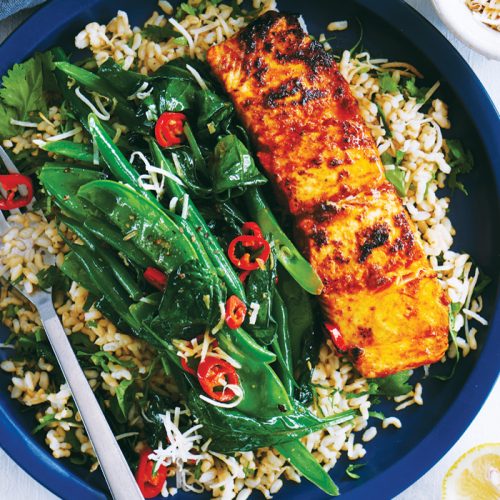
Saving up for a house doesn’t have to mean cutting back on healthy food. Dietitian Angela Berrill offers 15 tips to help you eat well and save.
Saving to buy a home can be a real struggle, especially with ever-increasing house prices. While saving for a deposit can come with its own set of self-imposed rules and limitations, it doesn’t mean you have to ditch healthy eating along the way. Yes, you might have to save café brunches for a special treat and not buy into the latest over-priced superfood craze, but with a few simple tricks you can eat well on the way towards saving up a hefty deposit.
The University of Otago Annual Food Cost Survey estimates how much healthy families or individuals need to spend to meet their nutritional needs. The costs are calculated assuming mostly home preparation of meals and dishes, and that food is purchased from supermarkets.
In 2019, a basic weekly shop for an adult man living in Auckland, Christchurch or Dunedin was estimated at $68-71 and for a woman $58-61 per week. Spending less than this increases the risk of not getting all the necessary nutrients. It might not sound like much to spend each week on your groceries, so how do you eat healthily while keeping your weekly food cost down?
Here are 15 effective tips.
1. Create a budget
It might sound simple but the real trick is sticking to it. Schedule some time to sit down and work out how much you plan to spend each week. That includes any food or drink that you purchase from a supermarket, local market, dairy, café or restaurant. Also see if there are any other parts of your budget that could be tightened up too – every little bit of savings counts.
2. Plan ahead
Being organised is key to helping you to achieve your savings goals. Each week, spend some time thinking about what meals and snacks you will have during the week ahead. By spending a few minutes planning your weekly ‘menu’, you will not only save more money by not buying items you don’t need but, chances are, you’ll eat better too. If you always have the right meal ingredients at home, you’re less likely to fall into the ‘5pm panic’, where you can’t think of what to cook and are left calling for takeaways.
3. Write a shopping list
Using your new menu plan, write your shopping list of ingredients you will need. Make sure you check what food you already have at home (whether it’s in your pantry, fridge or freezer) to avoid any double-ups.
4. Shop online
If you find it hard to avoid temptation as you walk down the supermarket aisles, online shopping could be the answer for you. Your running total is calculated as you shop, making it easier to make sure you’re sticking to your budget. And there are savings to be made on delivery. Countdown offers ‘delivery saver’ vouchers where you can prepay three or six months of unlimited deliveries which, if used often, save you money compared with paying for individual deliveries. Using these prepaid vouchers, you can end up having your groceries delivered for less than the cost of a latte, or the petrol needed to get you to the supermarket.
5. Shop around
If you have the time, it can often be cheaper to shop around and visit your local market, butcher or fruit and vegetable shop to snap up a bargain or two.
6. Buy in season
Buying fruit and vegetables when they are in season is usually cheaper than buying when they are out of season.
Example: A few months back, when avocados were out of season they cost about $5.99 from the supermarket. But in season they can cost as little as 50 cents, saving you $5.49 per avocado.
7. Grow your own
If you have a little space and a green thumb, you could try growing some of your own fruit, vegetables and herbs to supplement your meals as required.
8. Frozen and canned still count
Frozen and canned foods are often just as nutritious as fresh, and are usually cheaper. They can also be a good non-perishable option to have on hand, when a food is out of season or unavailable.
Example: A small (95g) can of salmon costs around $1.80, whereas 95g of fresh salmon costs around $3.42. That’s a saving of $1.62.
9. Embrace the legume
The humble legume is often overlooked on shopping lists. Not only do legumes pack a punch nutritionally, but they can be low cost, meaning the more meals you can add them to, the better. By adding them to your favourite meat-based dishes you also spread the expensive meat portion further.
Example: Two 400g cans of chickpeas (around 500g of chickpeas when drained) costs around $3, whereas 500g of beef mince is around $10.
By replacing one mince-based meal with chickpeas each week, you could save about $364 in a year.
10. Look out for specials
While buying food on special is a logical way to save your precious dollars, there are often even cheaper alternatives available. Become savvy at reading the ‘cost per 100g’ tags, to make sure you really are getting the best deals available, rather than simply looking for the promotional specials.
11. Buy in bulk
Buying in bulk can be a cheaper option, but not always. As with buying items on special, it pays to check to ‘cost per 100g’ to make sure you really are getting a better deal.
12. Home in on house brands
House brands are product lines made specifically for or by the retailer that are often cheaper than their branded counterparts. Examples include Pams, Homebrand, Budget and Select. Good savings can be made on basic food items, such as flour, milk, oats, brown rice or legumes, and they’re not really any different than more expensive branded products.
Example: 2L of Homebrand trim milk costs around $3.49, whereas 2L of branded milk costs about $4.53. By just switching one 2L branded bottle of milk a week for a house brand equivalent, you could save $54.60 per year.
13. Love food, hate waste
Try to be mindful of how much food you throw away. We can end up throwing away perfectly good food, and our hard-earned money along with it. Try to use all of the vegetable, from root to tip. Remember the ‘best-before’ date doesn’t mean the same as a ‘use-by’ date. Food may still be safely eaten after the ‘best before’ date has passed, although it may have lost some of its quality.
14. Cook from scratch
Brush up on your cooking skills and cook meals from scratch using simple, whole ingredients. This can save you money compared with buying ready-to-eat meals, meal bases and, of course, eating out. While convenience is a key reason for purchasing prepared foods, it does come at a premium. Where you can, try to be smart with your time. If you’re cooking a meal from scratch, make extra so that you can use the leftovers throughout the week or to stock up the freezer.
Example: Half an avocado on a slice of sourdough toast costs about $4 to make at home, but smashed avocado on toast at a café could cost you about $20. If you eat smashed avocado once a week, then you could save yourself $832 a year by making it at home instead.
15. Eating out doesn’t need to include a full meal
If you really enjoy eating out at local cafés or restaurants and having smashed avocado at home doesn’t quite cut it, set yourself a realistic budget. Good savings can also be made by only ordering an entrée, side or a coffee, rather than a full meal.
How much will I save over a year?
The annual Food Cost Survey estimates by following a ‘basic’ food cost diet, rather than being a ‘liberal’ shopper, a man living in Auckland or Wellington could save himself $32 per week or $1872 per year.
A woman living in Auckland, Wellington or Christchurch could save herself $30 per week or $1560 per year. Men living in Christchurch could save themselves $1820 per year whereas, in Dunedin, men could save $1924 and women $1612 per year. And, if you are regularly purchasing food or drink made outside home, or if your regular weekly grocery shop is higher than that of the estimated ‘liberal’ shopper, you are likely to experience even greater savings by following a ‘basic’ food cost diet.
While healthy eating on a budget may take a little more time, planning and knowledge, it is still possible to save for your house, without compromising good nutrition.
Find out more about the Food Cost Survey by visiting tinyurl.com/foodcostsurvey.
Article sources and references
- Information package for users of the New Zealand estimated food costs 2019 (Food Cost Survey 2019). Department of Human Nutrition, University of Otago.https://ourarchive.otago.ac.nz/bitstream/handle/10523/9819/Food%20Costs%202019.pdf?sequence=1&isAllowed=y
www.healthyfood.com










